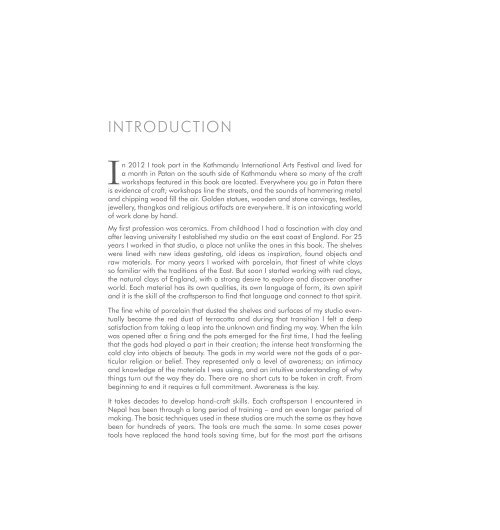Treasure of Nepal - Sample Flip Book
A few pages of Treasure of Nepal to give a taste of layout and content.
A few pages of Treasure of Nepal to give a taste of layout and content.
Create successful ePaper yourself
Turn your PDF publications into a flip-book with our unique Google optimized e-Paper software.
INTRODUCTION<br />
In 2012 I took part in the Kathmandu International Arts Festival and lived for<br />
a month in Patan on the south side <strong>of</strong> Kathmandu where so many <strong>of</strong> the craft<br />
workshops featured in this book are located. Everywhere you go in Patan there<br />
is evidence <strong>of</strong> craft; workshops line the streets, and the sounds <strong>of</strong> hammering metal<br />
and chipping wood fill the air. Golden statues, wooden and stone carvings, textiles,<br />
jewellery, thangkas and religious artifacts are everywhere. It is an intoxicating world<br />
<strong>of</strong> work done by hand.<br />
My first pr<strong>of</strong>ession was ceramics. From childhood I had a fascination with clay and<br />
after leaving university I established my studio on the east coast <strong>of</strong> England. For 25<br />
years I worked in that studio, a place not unlike the ones in this book. The shelves<br />
were lined with new ideas gestating, old ideas as inspiration, found objects and<br />
raw materials. For many years I worked with porcelain, that finest <strong>of</strong> white clays<br />
so familiar with the traditions <strong>of</strong> the East. But soon I started working with red clays,<br />
the natural clays <strong>of</strong> England, with a strong desire to explore and discover another<br />
world. Each material has its own qualities, its own language <strong>of</strong> form, its own spirit<br />
and it is the skill <strong>of</strong> the craftsperson to find that language and connect to that spirit.<br />
The fine white <strong>of</strong> porcelain that dusted the shelves and surfaces <strong>of</strong> my studio eventually<br />
became the red dust <strong>of</strong> terracotta and during that transition I felt a deep<br />
satisfaction from taking a leap into the unknown and finding my way. When the kiln<br />
was opened after a firing and the pots emerged for the first time, I had the feeling<br />
that the gods had played a part in their creation; the intense heat transforming the<br />
cold clay into objects <strong>of</strong> beauty. The gods in my world were not the gods <strong>of</strong> a particular<br />
religion or belief. They represented only a level <strong>of</strong> awareness; an intimacy<br />
and knowledge <strong>of</strong> the materials I was using, and an intuitive understanding <strong>of</strong> why<br />
things turn out the way they do. There are no short cuts to be taken in craft. From<br />
beginning to end it requires a full commitment. Awareness is the key.<br />
It takes decades to develop hand-craft skills. Each craftsperson I encountered in<br />
<strong>Nepal</strong> has been through a long period <strong>of</strong> training – and an even longer period <strong>of</strong><br />
making. The basic techniques used in these studios are much the same as they have<br />
been for hundreds <strong>of</strong> years. The tools are much the same. In some cases power<br />
tools have replaced the hand tools saving time, but for the most part the artisans


